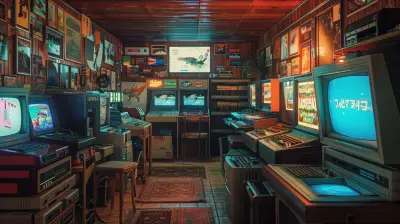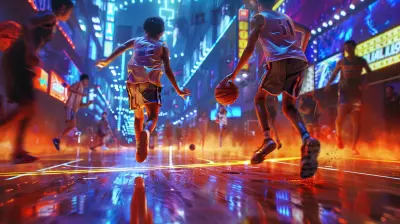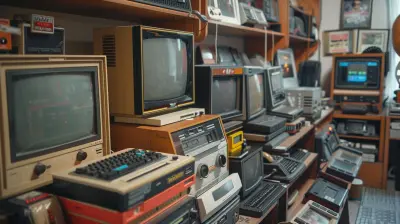Behind the Epic Sparkle: The Development of Iconic Legendary Items
11 October 2025
When you hear the term “legendary items” in gaming, do you feel a little rush of excitement? Like, "Oh boy, this is going to be good!" You're not alone. Legendary items have carved out a special place in gaming culture, embodying a mix of prestige, power, and sometimes a sprinkling of frustration (because, let's face it, RNG isn't always on our side). But have you ever stopped to wonder what goes into crafting these iconic pieces of loot? I promise, it’s not just about slapping a rare texture on a piece of gear and calling it a day.
This is where the magic happens—coding, designing, and storytelling collide to give us those unforgettable items that we grind hours (sometimes days!) to acquire. So buckle up! We’re going behind the scenes to uncover the development of legendary items that sparkle with epicness.![]()
What Makes an Item Legendary?
Before diving into the process, let’s break down the basics: what exactly is a legendary item? It’s more than just a flashy weapon or armor with a shiny gold border. Legendary items are the pinnacle of in-game achievement. They have unique stats, provide game-changing abilities, and often come with a backstory that ties them into the lore of the game.Think of them like that one-of-a-kind, hand-crafted treasure in a digital sea of mass-produced gear. They stand out. A legendary item is meant to feel earned, not handed to you on a silver platter. Whether it’s Thunderfury, Blessed Blade of the Windseeker in World of Warcraft, or the Master Sword in The Legend of Zelda, these items carry weight—not just in power but in emotional impact.![]()
The Creative Spark: Concept Development
Ever heard the phrase, “Every great masterpiece starts with an idea”? That holds true for legendary items too. The development process kicks off with brainstorming and design meetings. Developers and designers ask themselves questions like:- What role does this item play in the game’s story?
- Does it tie into the game’s lore or significant moments in history?
- How will it make the player feel when they acquire it?
For instance, in games like Diablo or Destiny 2, legendary items aren’t just gear; they’re stories. Weapons often have names and descriptions that hint at a mysterious past or heroic deed. These little breadcrumbs of lore make players emotionally attached to them, turning a simple in-game object into something truly iconic.![]()
The Balancing Act: Design and Stats
Creating a legendary item is like walking a tightrope—it has to be powerful (because duh, it’s legendary), but not so overpowered that it throws game balance out the window. This is where the math geeks, also known as game designers, come in. They fine-tune every stat, ability, and perk that the item has.Imagine you’re developing an in-game sword. It can’t just slice through enemies like butter without some form of balance. Maybe it does crazy-high damage, but it has a slow attack speed. Or maybe it comes with a risk-reward mechanic—like draining some of your health with every swing but dealing massive AoE damage. These trade-offs not only make the item fair but also add depth to gameplay.
To put it in perspective, think about the Gjallarhorn rocket launcher in Destiny. When it first launched, it was the king of all weapons—so much so that it unintentionally encouraged players to exclude anyone who didn’t have it. As a result, it had to be nerfed (cue collective groan), but the balancing tweak helped maintain fairness in the game’s ecosystem.![]()
The Visual Sparkle: Art and Animation
Let’s be real. Part of what makes legendary items so, well, legendary is their jaw-dropping visuals. Nobody wants their hard-earned item to look like something you picked up at a garage sale (no offense to basic gear). Legendary items are crafted to stand out.Artists go all out here. Custom textures, intricate designs, and particle effects are the name of the game. That fiery axe that leaves a trail of flames or the bow that glows when you aim? That’s not an accident. It’s the result of hours of digital artistry and animation magic.
Ever notice how some items simply feel different? That’s intentional, too. Great visuals are paired with tactile feedback. For instance, in Elden Ring, wielding a colossal legendary weapon gives you this oomph as it lands heavy blows. Every sound effect, animation, and visual makes you feel the power in your hands.
Tying It All Together: Lore and Storytelling
Legendary items aren’t just weapons and gear; they’re stories waiting to be told. Developers often create intricate backstories to make the items feel alive. Some items are tied to famous in-game characters or events, while others might hint at future expansions or hidden lore.Take The One Ring from The Lord of the Rings Online. This isn’t just an accessory; it’s the item that drives the entire story. Owning it makes players feel innately connected to the epic narrative. Similarly, games like Final Fantasy XIV weave legendary weapons into quests, making them an integral part of the player’s journey.
The Grind (Both for Players and Developers)
If you’ve ever spent weeks grinding for a legendary item, you know it’s a labor of love (or perhaps frustration, depending on your RNG luck). But here’s the kicker: the grind isn’t just hard for players—it’s a monumental effort for developers too.You see, legendary items often come with unique acquisition methods to ensure they feel earned. This could be a rare drop from a boss, a lengthy questline, or crafting with hard-to-find materials. Developers have the tricky job of designing these systems to be challenging but not so frustrating that players throw their keyboards across the room.
For example, the Legendaries in World of Warcraft often require careful planning. Developers look at factors like player activity, difficulty, and progression pacing when designing the grind. They ask, “How much effort is just enough to make this item feel rewarding without it becoming downright ridiculous?”
The Evolution of Legendary Items
It’s interesting to see how legendary items have evolved over the years. In the early days, they were simple yet powerful—essentially the cherry on top of endgame content. But as games became more complex, so did legendary items.Modern games often include RNG mechanics, alternate ways to earn Legendaries (like crafting or battle passes), and even evolving gear that grows stronger with you. This makes them more accessible while still maintaining that “legendary” feeling.
Plus, there’s the rise of online communities analyzing every detail about legendary items. Ever watched a streamer freak out after finally scoring that one elusive drop? Yeah, it’s pure gold.
What Do Legendary Items Mean for Players?
At the end of the day, legendary items mean different things to different people. For some, they’re symbols of prestige—proof you’ve conquered the game’s toughest challenges. For others, they’re about the journey—the friends you made, the bosses you defeated, the hours you poured in. And let’s not forget the dopamine hit that comes when you see that shiny orange-colored loot drop.Legendary items aren’t just a part of gaming; they’re a connection between the player and the world the developers have built. They remind us that sometimes the most satisfying part of the game isn’t just the destination—it’s the adventure along the way.
Final Thoughts
Behind every legendary item lies a mix of creativity, hard work, and a dash of frustration (both on the developer and player sides!). Whether it’s the intricate lore, the stunning visuals, or the sense of accomplishment they bring, legendary items embody what we love most about gaming: the thrill of the chase, the joy of discovery, and the stories we share along the way.So next time you stumble upon a legendary item in your favorite game and feel that electric rush, take a moment to appreciate all the layers that went into crafting it. It’s not just an item; it’s an experience.
all images in this post were generated using AI tools
Category:
Legendary ItemsAuthor:

Madeleine McCaffrey
Discussion
rate this article
1 comments
Skylar McGrady
Every legendary item tells a story of creativity and passion—let's celebrate the magic of game development!
October 12, 2025 at 2:49 AM

Madeleine McCaffrey
Absolutely! Each legendary item embodies the hard work and imagination of developers. Let's honor their creativity!


